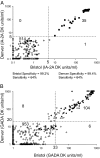Harmonization of glutamic acid decarboxylase and islet antigen-2 autoantibody assays for national institute of diabetes and digestive and kidney diseases consortia
- PMID: 20444913
- PMCID: PMC2928900
- DOI: 10.1210/jc.2010-0293
Harmonization of glutamic acid decarboxylase and islet antigen-2 autoantibody assays for national institute of diabetes and digestive and kidney diseases consortia
Abstract
Background/rationale: Autoantibodies to islet antigen-2 (IA-2A) and glutamic acid decarboxylase (GADA) are markers for diagnosis, screening, and measuring outcomes in National Institute of Diabetes and Digestive and Kidney Diseases (NIDDK) consortia studies. A harmonization program was established to increase comparability of results within and among these studies.
Methods: Large volumes of six working calibrators were prepared from pooled sera with GADA 4.8-493 World Health Organization (WHO) units/ml and IA-2A 2-235 WHO units/ml. Harmonized assay protocols for IA-2A and GADA using (35)S-methionine-labelled in vitro transcribed and translated antigens were developed based on methods in use in three NIDDK laboratories. Antibody thresholds were defined using sera from patients with recent onset type 1 diabetes and healthy controls. To evaluate the impact of the harmonized assay protocol on concordance of IA-2A and GADA results, two laboratories retested stored TEDDY study sera using the harmonized assays.
Results: The harmonized assays gave comparable but not identical results in the three laboratories. For IA-2A, using a common threshold of 5 DK units/ml, 549 of 550 control and patient samples were concordantly scored as positive or negative, specificity was greater than 99% with sensitivity 64% in all laboratories. For GADA, using thresholds equivalent to the 97th percentile of 974 control samples in each laboratory, 1051 (97.9%) of 1074 samples were concordant. On the retested TEDDY samples, discordance decreased from 4 to 1.8% for IA-2A (n = 604 samples; P = 0.02) and from 15.4 to 2.7% for GADA (n = 515 samples; P < 0.0001).
Conclusion: Harmonization of GADA and IA-2A is feasible using large volume working calibrators and common protocols and is an effective approach to ensure consistency in autoantibody measurements.
Figures





References
-
- American Diabetes Association 2008 Diagnosis and classification of diabetes mellitus. Diabetes Care 31:S55–S60 - PubMed
-
- Törn C, Mueller PW, Schlosser M, Bonifacio E, Bingley PJ; Participating Laboratories 2008 Diabetes Antibody Standardization Program: evaluation of assays for autoantibodies to glutamic acid decarboxylase and islet antigen-2. Diabetologia 51:846–852 - PubMed
Publication types
MeSH terms
Substances
Grants and funding
- DK 63821/DK/NIDDK NIH HHS/United States
- R01 HL079611/HL/NHLBI NIH HHS/United States
- UC4 DK063821/DK/NIDDK NIH HHS/United States
- P30 DK57516/DK/NIDDK NIH HHS/United States
- DK 63790/DK/NIDDK NIH HHS/United States
- DK 63836/DK/NIDDK NIH HHS/United States
- R01 HL61753/HL/NHLBI NIH HHS/United States
- R01 HL061753/HL/NHLBI NIH HHS/United States
- P30 DK057516/DK/NIDDK NIH HHS/United States
- DK 63865/DK/NIDDK NIH HHS/United States
- DK 63863/DK/NIDDK NIH HHS/United States
- U01 DK063829/DK/NIDDK NIH HHS/United States
- DK 63829/DK/NIDDK NIH HHS/United States
- UC4 DK063829/DK/NIDDK NIH HHS/United States
- DK 63861/DK/NIDDK NIH HHS/United States
- M01 RR000051/RR/NCRR NIH HHS/United States
LinkOut - more resources
Full Text Sources
Other Literature Sources

